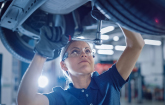The expansion of renewable energy sector, particularly wind power, has significantly increased the demand for robust steel castings, which are essential for manufacturing critical components such as turbine hubs and generator frames. These components must endure substantial mechanical stresses and harsh environmental conditions, making steel an ideal material due to its strength, durability, and recyclability.
WILMINGTON, Del., Nov. 5, 2025 /PRNewswire/ -- Allied Market Research published a report, titled, "Steel Casting Market by Type (Carbon Steel, Low-Alloy Steel, High-Alloy Steel, and Others), Process (Sand Casting, Investment Casting, Die Casting, and Others), and Application (Power Generation, Rail and Transit, Mining, Construction Machinery, Oil & Gas, and Others): Global Opportunity Analysis and Industry Forecast, 2025-2034". According to the report, the "steel casting market" was valued at $33.1 billion in 2024, and is estimated to reach $55.6 billion by 2034, growing at a CAGR of 5.4% from 2025 to 2034.
Expansion of Manufacturing and Infrastructure Projects
Surge in number of manufacturing and infrastructure projects is a pivotal driver for the steel casting industry. In the U.S., the Infrastructure Investment and Jobs Act (IIJA), enacted in November 2021, allocated $1.2 trillion to modernize the nation's infrastructure. Notably, in March 2022, an additional $166.5 million was invested in 108 infrastructure projects, encompassing energy infrastructure, roads, bridges, and highways, all of which require substantial steel components. Similarly, the National Investment and Infrastructure Fund (NIIF) in India committed $365.5 million (Rs 3,036 crore) to the J&K tunnel road project in July 2022, highlighting the country's focus on enhancing its infrastructure. Asia-Pacific countries have experienced rapid industrialization. India, for instance, is set to establish 12 new steel plants by 2030, aiming for a combined production capacity of 60 million tons per year. This expansion is driven by increase in demand for steel casting in sectors such as automotive, construction, and energy. Government initiatives, including the development of National Investment Manufacturing Zones such as Kalinganagar in Odisha, further bolster this growth by providing infrastructure and policy support.
Download Sample Pages of Research Overview: https://www.alliedmarketresearch.com/request-sample/A07528
The growth of the automotive and transportation sectors
The automotive and transportation sectors have experienced significant expansion, driven by technological advancements, regulatory pressures, and evolving consumer preferences. This growth has notably increased the demand for lightweight, high-strength steel castings essential for various vehicle components. The global shift toward electric vehicles has been particularly pronounced in China, the world's largest EV market. In 2024, China sold 12.87 million passenger electric vehicles, with 60% being battery electric vehicles (BEVs) and 40% plug-in hybrid electric vehicles (PHEVs), accounting for 47.9% of total automotive sales in the country. This rapid adoption has spurred the need for specialized steel castings in EV components such as battery housing, electric motor casings, and structural frames.
Advancements in casting technologies have played a crucial role in meeting the evolving demands of the automotive industry. Innovations such as lost-foam casting and vacuum die casting have improved casting quality and reduced production costs. In addition, the trend toward vehicle light-weighting, driven by emission regulations and fuel efficiency norms, has led to a shift from traditional materials to high-strength steel (HSS) and aluminum in casting applications
Report Coverage & Details:
| Report Coverage |
Details |
| Forecast Period |
2025–2034 |
| Base Year |
2024 |
| Market Size in 2024 |
$33.1 billion |
| Market Size in 2034 |
$55.6 billion |
| CAGR |
5.4 % |
| No. of Pages in Report |
426 |
| Segments Covered |
Type, Process, Application, and Region |
| Drivers |
Rising demand for steel casting in industrial sectors Advancements in alloy steel |
| Opportunity |
Increase in demand for additive manufacturing or 3D printing |
| Restraint |
Competition from alternative materials |
Rising Investments in Green Building Materials
The steel industry has made significant strides toward reducing its carbon footprint, aligning with the broader goals of sustainable construction. In 2024, Salzgitter Flachstahl GmbH, a subsidiary of Salzgitter AG, signed a long-term Power Purchase Agreement (PPA) to enable the future production of green steel. In addition, ArcelorMittal launched the XCarb Program, focusing on achieving carbon-neutral steel production by leveraging innovative technologies and increasing the use of renewable energy sources. The adoption of eco-friendly steel castings is becoming increasingly integral to green building projects. Steel castings produced using sustainable methods offer enhanced durability, recyclability, and energy efficiency, aligning with the principles of green building standards. For instance, the use of recycled steel and low-carbon production techniques in casting processes contributes to the overall sustainability of construction projects.
Request For Customization: https://www.alliedmarketresearch.com/request-for-customization/A07528
Increasing Demand for Steel Castings in Heavy-duty Vehicles in Asia-Pacific
The Asia-Pacific region has witnessed a significant uptick in demand for steel castings in heavy-duty vehicles, including trucks and buses. This surge is primarily driven by rapid urbanization, infrastructural development, and the expansion of logistics networks across countries such as China, India, Japan, and Southeast Asia. India is on track to achieve a steel production capacity of 300 million tons by 2030-31, up from nearly 200 million tons in 2024-25. This expansion is part of a government strategy to reduce dependence on steel imports and bolster the domestic industry. In June 2022, Brakes India and Volvo Group launched the industry's first Green Iron Castings, produced at Brakes India's foundries. These castings are used in Volvo's engines and are part of a shared commitment to lowering carbon emissions.
Moreover, manufacturers in China have made significant breakthroughs in integrated die casting technology. Companies such as Zhenzhi Machinery & Mould have developed large molds, with the latest weighing up to 250 tons, facilitating the production of complex vehicle components. The major players in China have acquired patents for non-heat-treatable aluminum alloys, such as Xiaomi's 'Xiaomi Titans Metal' and ZEEKR's 'Xianjing' alloy. These materials are used in integrated die casting for vehicle body structures, enhancing performance and reducing weight.
Competition from Alternative Materials is Expected to Hamper the Steel Casting Market
The rise in proliferation of alternative materials such as aluminum and composites is increasingly posing a competitive threat to traditional steel casting applications. Industries such as automotive, aerospace, and construction have seen a growing preference for these alternatives due to their lighter weight, improved performance, and in some cases, lower cost. Aluminum, for instance, is significantly lighter than steel, which is a crucial factor in industries such as automotive, where reducing vehicle weight leads to better fuel efficiency and lower emissions. Similarly, composite materials such as carbon fiber and fiberglass offer excellent strength-to-weight ratios and are highly resistant to corrosion, making them ideal for aerospace and marine applications. In the automotive industry, the shift toward electric vehicles (EVs) has accelerated the adoption of aluminum and composites, as these materials help in achieving lighter, more energy-efficient designs. The widespread use of aluminum for engine blocks, body panels, and chassis components is increasing, reducing the need for steel castings traditionally used in these applications
Bargaining Power of Supplier of Steel Casting
Suppliers of raw materials, particularly steel alloys and scrap metal, have experienced increased bargaining power due to volatility in commodity prices and supply chain disruptions. For instance, BHP highlighted concerns over declining demand for iron ore in China and anticipated increased labor costs in Australia, which could elevate production expenses and affect the global steel supply chain. Advancements in casting technologies have also shifted supplier dynamics. In December 2023, China Baowu Steel Group secured a patent for an innovative electromagnetic stirring device designed to efficiently cool molten steel, incorporating cooling water sprays to enhance the cooling process effectively. Such innovations can provide suppliers with a competitive edge, allowing them to offer specialized products that meet the evolving demands of the steel casting industry.
Environmental regulations and sustainability initiatives have further influenced supplier power. In November 2022, POSCO achieved ESG certification for two of its facilities, underscoring its commitment to sustainable practices. Suppliers who align with such standards can leverage their compliance to justify premium pricing, thereby enhancing their bargaining position in negotiations with steel casting manufacturers.
Leading Market Players: -
- ArcelorMittal
- Nippon Steel Corporation
- Eagle Alloy
- Jindal Steel & Power Ltd
- Harrison Steel Castings Company
- Ferralloy Inc
- Goodwin Steel Castings.
- Barron Industries
- WHEMCO Steel Castings
- William Cook Group
Recent Key Developments
- In March 2023, ArcelorMittal acquired Companhia Siderúrgica do Pecém, a 3-million-metric-ton blast furnace and slab plant in northeastern Brazil, for $2.2 billion.
- In December 2024, the Ministry of Steel introduced a classification system for 'green steel' based on carbon emissions per metric tonne produced. Steel with emissions below 2.2 tonnes per tonne is classified as 'green steel,' with stricter thresholds for higher ratings. This initiative aligns with India's goal to achieve net-zero emissions by 2070 and may influence procurement standards for public projects
- In November 2024, JSW Steel and South Korea's POSCO announced a $7.7 billion investment to establish an integrated steel plant in Odisha. The plant aims to produce 5 million metric tons per year initially, with plans to increase capacity to 18 million metric tons over three years, focusing on hot-rolled, cold-rolled, and galvanized steel.
The report provides a detailed analysis of these key players in the global steel casting market. These players have adopted different strategies such as new product launches, collaborations, expansion, joint ventures, and agreements to increase their market share and maintain dominant shares in different regions. The report is valuable in highlighting business performance, operating segments, product portfolio, and strategic moves of market players to highlight the competitive scenario.
Want to Access the Statistical Data and Graphs, Key Players' Strategies: https://www.alliedmarketresearch.com/steel-casting-market/purchase-options
𝐒𝐢𝐦𝐢𝐥𝐚𝐫 𝐑𝐞𝐩𝐨𝐫𝐭𝐬
- Curved Steel Market: Global Opportunity Analysis and Industry Forecast, 2023-2032
- Special Steel Market: Global Opportunity Analysis and Industry Forecast, 2021-2031
- Steel Wire Market: Global Opportunity Analysis and Industry Forecast, 2015-2040
- Steel Grating Market: Global Opportunity Analysis and Industry Forecast, 2020-2027
- U.S. Steel Grating Market: Global Opportunity Analysis and Industry Forecast, 2020-2027
- Carbon Steel Market: Global Opportunity Analysis and Industry Forecast, 2023-2032
- India Special Steel Market: Global Opportunity Analysis and Industry Forecast, 2021-2035
About Us
Allied Market Research provides global enterprises as well as medium and small businesses with unmatched quality of "Market Research Reports" and "Business Intelligence Solutions." AMR has a targeted view to provide business insights and consulting to assist its clients to make strategic business decisions and achieve sustainable growth in their respective market domain.
Pawan Kumar, the CEO of Allied Market Research, is leading the organization toward providing high-quality data and insights. We are in professional corporate relations with various companies and this helps us in digging out market data that helps us generate accurate research data tables and confirms utmost accuracy in our market forecasting. Each and every data presented in the reports published by us is extracted through primary interviews with top officials from leading companies of domain concerned. Our secondary data procurement methodology includes deep online and offline research and discussion with knowledgeable professionals and analysts in the industry.
Contact:
David Correa
United States
1209 Orange Street,
Corporation Trust Center,
Wilmington, New Castle,
Delaware 19801 USA.
Int'l: +1-503-894-6022
Toll Free: +1-800-792-5285
Fax: +1-800-792-5285
help@alliedmarketresearch.com
Web: www.alliedmarketresearch.com
Allied Market Research Blog: https://blog.alliedmarketresearch.com
Follow Us on | Facebook | LinkedIn | YouTube |
Logo: https://mma.prnewswire.com/media/636519/Allied_Market_Research_Logo.jpg






Share this article